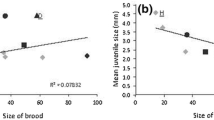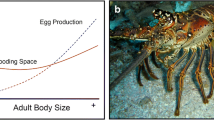Abstract
Changes in size, morphology, and biochemical composition in adults and embryos of a brooding sea star, Neosmilaster georgianus (Sladen), were studied in a population adjacent to Anvers Island, Antarctic Peninsula (64°46′S; 64°04′W) during the austral spring, 1991. Five morphological stages of development were designated in 24 broods, and for each the weight and biochemical composition of the brooding adults and their embryos were determined. Between Stage 1 and 2, the dry weight (dw) and organic weight (ow) of the embryo did not change. From Stage 2 to 3, the dw and ow increased significantly by 10%. Stage 2 and 3 embryos were in clusters of a few (2 to 10) to as many as 40 individuals. In the smaller clusters, individual embryos were attached by tissue cords to another, sometimes atrophied, brood member. In the larger clusters, they were attached to a central mass of tissue containing remnants of embryos. We interpret these interactions as a form of cannibalism which may account for the weight gains between Stage 2 and 3. During Stages 4 and 5, as juvenile form was approached, the dw and ash weight of the young increased significantly and the ow decreased significantly. The calculated energy content for the juvenile (Stage 5) was not significantly different from the energy content of the earliest undifferentiated stage (Stage 1), an indication that most of the organic matter in the egg is the primary contribution to the large juvenile. In brooding females, pyloric caeca indices declined by 52% from Stage 1 to Stage 5 and pyloric energy stores declined by 63% due to proportionately equivalent declines in protein and lipid. The ovary index was low and increased only slightly during brood protection, while the size of the largest oocytes remained approximately 23% that of ova. Energy stores in the pyloric caeca of brooding N. georgianus thus become depleted over a long period of incubation during which the adults apparently starve. This may delay oocyte development and ultimately limit the frequency of individual reproduction.
Similar content being viewed by others
Author information
Authors and Affiliations
Additional information
Received: 15 September 1998 / Accepted: 9 March 1999
Rights and permissions
About this article
Cite this article
Bosch, I., Slattery, M. Costs of extended brood protection in the Antarctic sea star, Neosmilaster georgianus (Echinodermata: Asteroidea). Marine Biology 134, 449–459 (1999). https://doi.org/10.1007/s002270050561
Issue Date:
DOI: https://doi.org/10.1007/s002270050561




